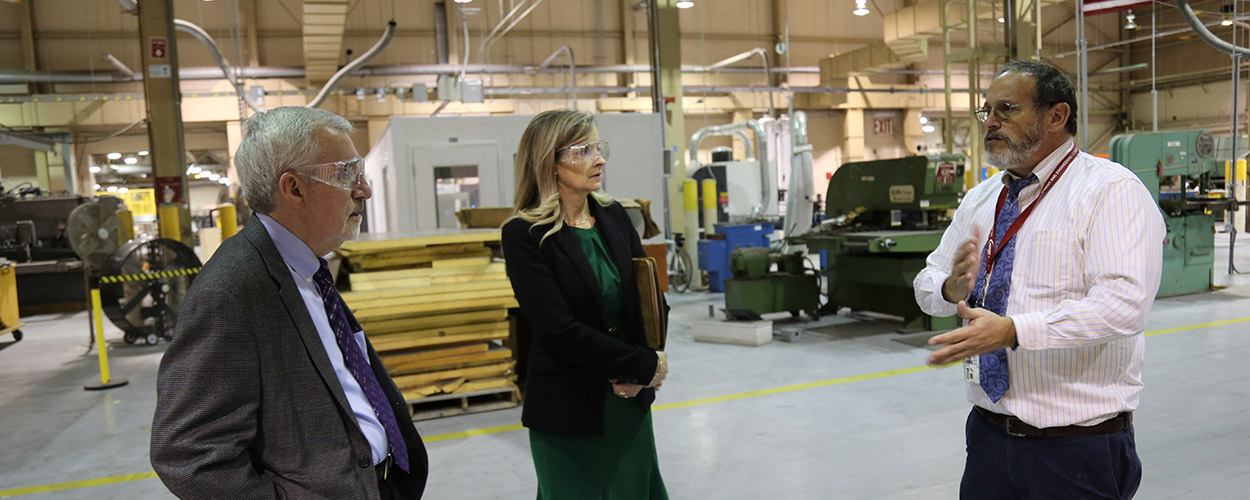Meeting Paves Way for Additive Manufacturing Apprenticeships
Meeting Paves Way for Additive Manufacturing Apprenticeships
Maryland commerce officials, RDECOM C&B Center leaders agree on need for workforce development
By Bradley Kroner
Collaborative efforts between the Maryland Department of Commerce and the U.S. Army Research, Development and Engineering Command Chemical & Biological (RDECOM C&B) Center could yield new apprenticeship and internship programs.
Two officials from the Department of Commerce toured the Center’s Product Development Facility to learn more about additive manufacturing and how an expanded partnership could grow the industry and its workforce.
Using additive manufacturing since 1989, the RDECOM C&B Center is a pioneer in the field, using the process to create drones, sensors, and other tools for the warfighter. Since 2014, the Center has been a member of the Regional Additive Manufacturing Partnership of Maryland (RAMP MD), a public-private partnership consisting of industry leaders, educational institutions, nonprofits, and government agencies.
Through this partnership, the RDECOM C&B Center served as a model for private-sector companies looking to expand additive manufacturing efforts.
“Local industry is using the Army to get up to speed and make Maryland a leader in this industry,” explained Mark Schlein, associate director for product development in the Center’s Engineering Directorate. “Additive manufacturing has been around for quite some time, and now, it’s starting to get into the hands of the masses. They’re looking to see where this capability is going in the future.”
Sharon Markley, director of education and innovation in the Commerce Department’s Office of Strategic Industries and Entrepreneurship, said she hoped to explore the possibility of expanding apprenticeships and internships, perhaps through working with regional community colleges.
“It’s incredibly striking that the capabilities here are available not just the military, but to businesses and students,” Markley said.
Markley remarked that one employee found work at the Center after going to community college to learn about computer-aided design. She said she hopes to create similar opportunities by working with the Center, RAMP MD, the Maryland Technology Council, and the Department of Labor, Licensing, and Regulation.
“The next steps are to connect with RAMP MD to talk about how they can serve as the organizing body on behalf of the Center to identify what types of apprenticeships and internships could be available,” she said.
Because additive manufacturing is still a relatively new industry, the workforce is fairly small. By working with the Commerce Department, Schlein hopes to grow an effective apprenticeship or internship program, which could in turn boost the Center’s production.
“We have a seven acre site with a state-of-the-art lab, so we have a lot of capacity here to perform more product development for the warfighter,” Schlein explained. “What we need is a larger workforce to accommodate a surge in production.”
Additive manufacturing differs from conventional methods in that instead of manufacturing parts by subtracting from raw materials, this process builds up, essentially printing layers of materials – like plastics and metal powder – to form an object. Combined with computer-aided design, additive manufacturing enables rapid prototyping and reverse engineering to accelerate the design process.
Expanded partnerships could also yield benefits for research and development through enhanced collaboration and cross-pollination with industry peers.
“By connecting with private-sector leaders, we can stay relevant and stay in touch with the people who are making breakthroughs, giving us early access to emerging technologies,” Schlein said. “The further ahead we are in the field, the better we can achieve our mission and deliver new capabilities to warfighters.”
Retired Brig. Gen. Dean Ertwine, the Commerce Department’s assistant director for military and federal affairs, said he saw opportunities for the Center to help grow a burgeoning field by sharing knowledge with industry, especially with small businesses.
“It’s fair to say that Aberdeen Proving Ground and the RDECOM C&B Center are on the forefront of additive manufacturing, and we’re fortunate for the Center being involved with RAMP MD,” he said. “With our awareness now of what’s going on at the RDECOM C&B Center, we can tie that in with other manufacturing entities and enable more access, especially for small businesses that have a need for additive manufacturing but might not have the experience or the money.”
Schlein told Ertwine and Markley that, through RAMP MD, businesses can pay the RDECOM C&B Center to make products or even to use the equipment directly.
Speaking about how additive manufacturing “enables capabilities that weren’t there otherwise,” Ertwine pointed out that one mask he saw had pieces that would be “nearly impossible” to create using conventional methods.
“But with additive, it’s just a matter of scanning and programming to get an item you couldn’t make otherwise,” he said. “It’s an irreplaceable capability that you just can’t do any other way.”
Dean Ertwine and Sharon Markley of Maryland’s Commerce Department toured the ADM facility with Mark Schlein, RDECOM C&B Center's associate director of product development.

